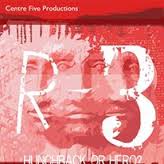
July 18, 2013, by Peter Kirwan
R-3: Hunchback or Hero? (Centre Five Productions) @ Leicester Guildhall
This is a direct reproduction of a review for Exeunt Magazine.
As R-3: Hunchback or Hero? was being devised in London in August 2012, the bones of Richard III were discovered serendipitously in Leicester. The revival of the production in Leicester itself was inevitable, and the eerie setting of the Mayor’s Parlour at Leicester’s Guildhall provides a suitable home for a one-man show with spirit and verve.
Audience members step over a bloodied corpse as they enter the small space, a corpse that rises as the house lights drop and the echoing voices of Richard III’s ghosts begin instructing him to ‘despair and die’. Timothy Allsop’s R-3 is an enigma. Picking up and reading from descriptions of Richard by Polydore Vergil, Thomas More and Shakespeare, he rejects those interpretations in turn. Yet he is himself a fiction, a shadow of the historical king who sometimes flirts with the audience, sometimes refers to himself in the third person, sometimes appears to relive his pain. He is also an actor, sometimes voicing the other characters in his story, and sometimes painfully being forced by unseen powers to become Shakespeare’s hunchback.
This haunted figure, never Richard but ‘R-3’, acts as a showcase for Allsop’s ability to captivate an audience for forty-five minutes. Aside from the misjudged Jekyll-and-Hyde jerky transformations between R-3 and Shakespeare’s Richard (often accompanied by screams of ‘Don’t make me’), Allsop gives a compelling performance of a wronged figure, at war with a literary legacy that he claims has built canonical icons at the expense of one man’s reputation. While the production’s conceit is to put Shakespeare on trial for misrepresentation, there is no balance here: this is an appeal for vindication of which the Richard III Society would be proud.
The techniques used to make the case are varied. By far the strongest are the simplest: R-3’s direct appeals to the audience, particularly his tear-filled plea that his genuine love for Anne Neville not be rewritten, even if at the expense of the rest of his reputation. At other times he recreates the experience of humbling himself, crawling across the room to the vast fireplace in mimicry of the debasement required in coronation. The space of the Guildhall comes into its own as the mantelpieces, high chairs and heraldry are drawn into play by R-3, becoming the trappings of his state.
Yet the production also unfortunately patronises. The most entertaining section admits complicity in the death of Clarence by telling a fairy-tale featuring the noble Edward, the evil, moustache-twirling George and the heroic ‘Dick’, all delineated with gestures and sound effects. While dramatically effective and clear in its narration of an oft-forgotten aspect of the history (although one currently being dramatised in the BBC’s The White Queen), it also exposes the didactic nature of this polemic. In creating a composite central figure, the production avoids the more interesting potential for undercutting R-3’s own point of view – the character’s ‘truth’ is aligned with the historical truth against the evil fictions, where it could have been more interesting and challenging to introduce the possibility that R-3 is in fact lying to his audience.
Declan Randall’s lighting design creates a hellish red for this ghostly figure, finally fading on the image of the corpse resuming his prone position, this time on a central throne. The production’s key strength, though, is actually the one it should thank Shakespeare for – by drawing on the charismatic Machiavel, the great persuader of people and the self-aware villain, Allsop’s R-3 becomes a magnetic and compelling presence. While the overt nature of the polemic means that one remains suspicious of the playtext, the audience is invited, coerced and begged into sympathy with a figure doomed to be nothing more than his fictional legacy. Yet as the Guildhall’s clock chimed the quarter-hour, Allsop’s R-3 warned Shakespeare (represented by a Complete Works) that he too would be destroyed by time. As a warning against the danger presented by dominant canonical narratives, R-3: Hunchback or Hero? concluded with the intelligent and fatalistic assertion that no amount of persuasion could substitute for the ravages of time on one’s legacy.

R-3 – A masterful monologue cleverly exploiting the atmosphere of the Mayor’s Parlour at Leicester’s Guildhall to give a dark backdrop to the spirited narration. The plea of mitigation by R-3 is woven together to provide a historical framework both believable and acceptable in the context of those troubled times, but also, making the Tudors look like masters of propoganda and Shakespeare their puppet. What a thrilling production.